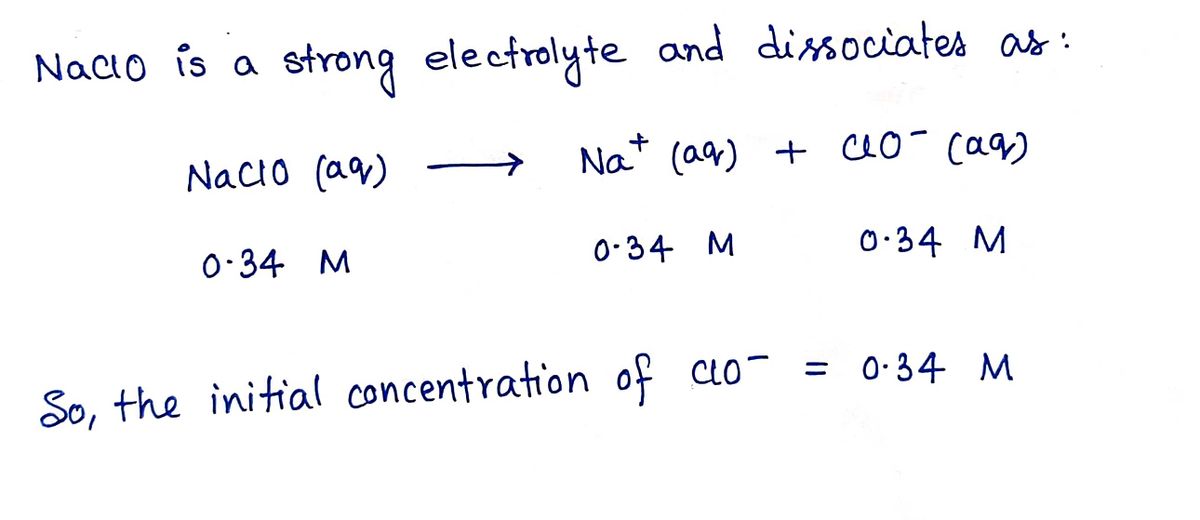A solution is prepared that is initially 0.27 M in hypochlorous acid (HCIO) and 0.34M in sodium hypochlorite (NaCIO). Complete the reaction table below, so that you could use it to calculate the pH of this solution. Use x to stand for the unknown change in initial change final [HCIO] 0 0 O [CIO] 0 0 [H₂0]. Y You can leave out the M symbol for molarity. 0 olo S
A solution is prepared that is initially 0.27 M in hypochlorous acid (HCIO) and 0.34M in sodium hypochlorite (NaCIO). Complete the reaction table below, so that you could use it to calculate the pH of this solution. Use x to stand for the unknown change in initial change final [HCIO] 0 0 O [CIO] 0 0 [H₂0]. Y You can leave out the M symbol for molarity. 0 olo S
Chemistry
10th Edition
ISBN:9781305957404
Author:Steven S. Zumdahl, Susan A. Zumdahl, Donald J. DeCoste
Publisher:Steven S. Zumdahl, Susan A. Zumdahl, Donald J. DeCoste
Chapter1: Chemical Foundations
Section: Chapter Questions
Problem 1RQ: Define and explain the differences between the following terms. a. law and theory b. theory and...
Related questions
Question
![A solution is prepared that is initially \(0.27\, M\) in hypochlorous acid \((\text{HClO})\) and \(0.34\, M\) in sodium hypochlorite \((\text{NaClO})\). Complete the reaction table below, so that you could use it to calculate the pH of this solution.
Use \( x \) to stand for the unknown change in \([\text{H}_3\text{O}^+]\). You can leave out the \( M \) symbol for molarity.
| | [HClO] | [ClO\(^-\)] | [H\(_3\)O\(^+\)] |
|---------------------|--------|-------------|------------------|
| **initial** | | | |
| **change** | | | |
| **final** | | | |
In the table, you will fill in the concentrations for each component at the initial, change, and final stages of the reaction. Use \( x \) to represent the change in hydronium ion concentration.](/v2/_next/image?url=https%3A%2F%2Fcontent.bartleby.com%2Fqna-images%2Fquestion%2Fa60cc6ce-11de-444a-af29-e9eb1b50e640%2Fec87f38c-8b7a-41fe-8b5e-68250875eaf2%2Fne20r4e_processed.png&w=3840&q=75)
Transcribed Image Text:A solution is prepared that is initially \(0.27\, M\) in hypochlorous acid \((\text{HClO})\) and \(0.34\, M\) in sodium hypochlorite \((\text{NaClO})\). Complete the reaction table below, so that you could use it to calculate the pH of this solution.
Use \( x \) to stand for the unknown change in \([\text{H}_3\text{O}^+]\). You can leave out the \( M \) symbol for molarity.
| | [HClO] | [ClO\(^-\)] | [H\(_3\)O\(^+\)] |
|---------------------|--------|-------------|------------------|
| **initial** | | | |
| **change** | | | |
| **final** | | | |
In the table, you will fill in the concentrations for each component at the initial, change, and final stages of the reaction. Use \( x \) to represent the change in hydronium ion concentration.
Expert Solution
Step 1: Find the initial concentration of ClO-

Step by step
Solved in 3 steps with 2 images

Knowledge Booster
Learn more about
Need a deep-dive on the concept behind this application? Look no further. Learn more about this topic, chemistry and related others by exploring similar questions and additional content below.Recommended textbooks for you

Chemistry
Chemistry
ISBN:
9781305957404
Author:
Steven S. Zumdahl, Susan A. Zumdahl, Donald J. DeCoste
Publisher:
Cengage Learning

Chemistry
Chemistry
ISBN:
9781259911156
Author:
Raymond Chang Dr., Jason Overby Professor
Publisher:
McGraw-Hill Education

Principles of Instrumental Analysis
Chemistry
ISBN:
9781305577213
Author:
Douglas A. Skoog, F. James Holler, Stanley R. Crouch
Publisher:
Cengage Learning

Chemistry
Chemistry
ISBN:
9781305957404
Author:
Steven S. Zumdahl, Susan A. Zumdahl, Donald J. DeCoste
Publisher:
Cengage Learning

Chemistry
Chemistry
ISBN:
9781259911156
Author:
Raymond Chang Dr., Jason Overby Professor
Publisher:
McGraw-Hill Education

Principles of Instrumental Analysis
Chemistry
ISBN:
9781305577213
Author:
Douglas A. Skoog, F. James Holler, Stanley R. Crouch
Publisher:
Cengage Learning

Organic Chemistry
Chemistry
ISBN:
9780078021558
Author:
Janice Gorzynski Smith Dr.
Publisher:
McGraw-Hill Education

Chemistry: Principles and Reactions
Chemistry
ISBN:
9781305079373
Author:
William L. Masterton, Cecile N. Hurley
Publisher:
Cengage Learning

Elementary Principles of Chemical Processes, Bind…
Chemistry
ISBN:
9781118431221
Author:
Richard M. Felder, Ronald W. Rousseau, Lisa G. Bullard
Publisher:
WILEY